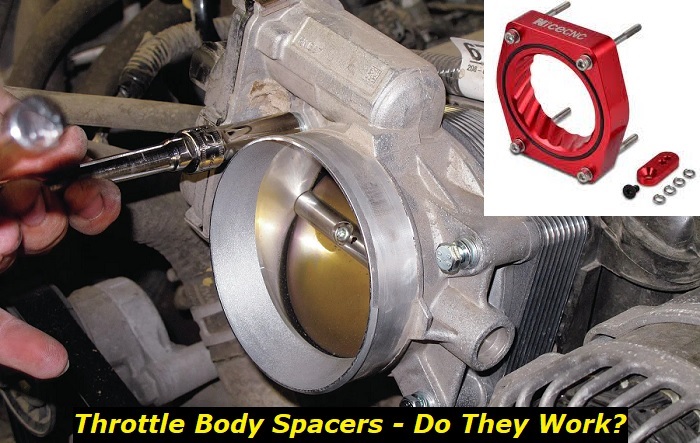Performance can mean a lot of things to a vehicle. One of the many ways you can achieve this is through the use of throttle body spacers. Although this upgrade holds many promises to vehicle owners, the truth is that it's not all rainbows and butterflies.
Engine upgrades highlights
- Commonsystems:fuel supply, air supply, exhaust, software
- Average prices:$500 - $6,500
- Average waiting time:1 - 21 days
- Commonreasons:higher power and torque
- DIY mods:just minor things, usually plug & play
- Level of satisfaction:medium

What are Throttle Body Spacers
Throttle body spacers are used to increase the air volume that flows into an engine. By increasing the air volume, engines can generate more power and gain improved fuel efficiency. The increased airflow provided by a throttle body spacer also allows for greater tuning potential when paired with other modifications, such as larger intake manifolds and bigger turbochargers.
The design of throttle body spacers is made up of three main components:
- A spacer plate, which separates the plenum from the intake manifold
- Gaskets or seals to keep it in place
- A mounting hardware
When installed correctly, the end result is better flow through the intake manifold caused by an enlarged plenum area behind it. This increases turbulence within the cylinder, providing for more complete combustion of fuel.
Things to Remember Before Considering the Installation of a Throttle Body Spacer
One must be well-informed regarding this upgrade before proceeding. This is to ensure that the mod is deemed necessary and that the risks that come with it are really understood.
Before getting this upgrade one must think about the following:
Step 1: Understand the Purpose of a Throttle Body Spacer
A throttle body spacer is a device that is designed to increase airflow into the intake manifold. This in turn can create more torque and horsepower, as well as improve engine efficiency. However, the reality is that these spacers have limited to no effect on performance gains and are more likely to cause problems in your vehicle.
Step 2: Determine if Your Vehicle Needs a Throttle Body Spacer
Before installing a throttle body spacer, you should determine whether or not your vehicle actually needs one. If you have a naturally-aspirated engine (with no turbocharger or supercharger) then a throttle body spacer won't do anything for you. However, if you have a turbocharged or supercharged engine, then it can provide a small performance gain.
Step 3: Install the Throttle Body Spacer
Once you have determined that your vehicle actually needs a throttle body spacer, you can begin the installation process. When doing so, there are certain steps that must be followed to ensure correct installation and avoid problems.
How are Throttle Body Spacers Installed
Installing a throttle body spacer is a straightforward process that should take no longer than a day. Here are the steps required:
- Start by removing the air intake system from your engine and disconnect the battery power cable.
- Unscrew and remove any existing hardware retaining the plenum to the intake manifold along with any gaskets or seals present.
- Clean up both surfaces of the plenum and manifold using solvent before installing the new spacer plate with its accompanying mounting hardware and seals/gaskets. You will need to install the spacer between the throttle body and the intake manifold, making sure that it is secure with all of the necessary bolts and gaskets.
- If you want to increase power further, you may want to install a larger intake manifold or a bigger turbocharger.
- Re-attach the air intake system and reconnect the battery power cable. Make sure that all clamps and hoses are connected properly, as a bad connection can cause performance issues with your vehicle.
- Start up your engine to check that everything is running correctly before taking it on a test drive. Take it for a spin around the block to see if there is any noticeable difference in performance or fuel economy. If not, then you may want to consider removing the spacer and returning your vehicle to its original state.
Once these steps are followed, you should be able to enjoy an increased level of performance from your vehicle as a result of installing throttle body spacers. As with any modification, make sure you have an expert look over your installation to ensure it's done properly for maximum gains in performance and fuel efficiency.
Adding throttle body spacers can be a relatively simple way to gain improved performance and fuel economy from your vehicle without major modifications or extensive tuning work.
The Benefits of Throttle Body Spacers
The advantages of installing a throttle body spacer are the following:
- Increased horsepower
- Increased torque
- Better fuel efficiency
- Improved response time from the engine
- Reduced emissions
- Enhanced sound quality from the exhaust system
All of these benefits make it an attractive upgrade for vehicle owners looking to improve their performance.
While there is no exact formula to calculate the gains achieved by this modification, results have shown that throttle body spacers can provide up to 20% more power and torque output on specially tuned setups. Ultimately though, its effectiveness will depend on the specific setup of your vehicle and its components. For best results, speak to an expert in order to ensure you get the most out of your installation.
In a nutshell, properly installed throttle body spacers can provide a great way to upgrade your vehicle's performance. With increased airflow, improved power, and fuel economy, it is an attractive option for car enthusiasts seeking improved performance from their vehicles. Make sure you consult an expert before making modifications to ensure that you get the most out of your installation and enjoy all the benefits of this modification.
The Potential Drawback of Throttle Body Spacers in a Vehicle
Putting throttle body spacers in an engine definitely sounds good on paper, however, it does carry certain risks. Here are the five major risks to keep in mind before getting this upgrade:
1. Poor Fitment
Depending on the type of throttle body spacer, it might not fit correctly when installed. If it is too loose or too tight, this could cause several issues, including engine misfiring and possibly even complete engine failure.
2. Increased Wear and Tear
Throttle body spacers can increase wear and tear on vital components due to increased turbulence and air velocity that comes with the installation. This can lead to increased maintenance costs over time as well as a decreased performance from your vehicle.
3. Unforeseen Fuel Waste
The added airflow provided by a throttle body spacer may reduce fuel efficiency if not tuned properly with other modifications such as larger intake manifolds and bigger turbochargers. This added fuel waste can lead to higher fuel costs over time.
4. Reduced Performance
Depending on the type of throttle body spacer, it might not provide the increased performance gains that you were expecting. If the airflow is not evenly distributed, this could lead to decreased power output as well as worse MPG ratings.
5. Emissions Issues
Throttle body spacers can also cause a decrease in emissions if they are not installed correctly, leading to potential fines or other penalties from government agencies for non-compliance with their standards.
Overall, throttle body spacers have many potential advantages in terms of improved performance and enhanced sound quality from the exhaust system. However, before considering any modifications to your vehicle, it is important to understand the risks associated with them. Knowing these potential drawbacks and consulting an expert beforehand, you can ensure that you get the most out of your installation while avoiding any costly issues in the future.
Alternatives to Throttle Body Spacers that You May Want to Consider
Instead of putting spacers in your throttle body, there are several safer alternatives that you can do. These include the following:
1. Cold Air Intake (CAI)
Installing a CAI will help direct more cold air into your engine's cylinders, aiding in the combustion process and ultimately providing increased power output and improved fuel economy.
2. Performance Exhaust System
Installing a performance exhaust system can provide enhanced sound quality while reducing back pressure in the exhaust system, leading to better overall performance from your vehicle.
3. Higher-Quality Spark Plugs
Increasing the quality of spark plugs used in your vehicle can improve ignition efficiency and result in improved power output as well as fuel economy gains.
4. Tuners and Upgrades
Adding performance-enhancing tuners or electronically controlled upgrades are other great ways to get more out of your vehicle. These can help optimize the fuel and air mixture within the engine, allowing for increased power output as well as improved fuel efficiency.
5. Upgrade Your Turbocharger
If you have a turbocharged vehicle, upgrading to a larger one can provide significant performance gains in horsepower and torque. Keep in mind that this is best done with other modifications such as CAI, tuned ECU, etc., to ensure proper fitment and maximum performance benefits.
By understanding all these alternatives to throttle body spacers, car enthusiasts can make an informed decision when considering modifications for their vehicles. Furthermore, consulting an expert before performing any upgrade or modification will ensure that you get the most out of your installation and enjoy the benefits without any risks.
Conclusion
When it comes to throttle body spacers, the truth is that they simply don't deliver on their promises. In fact, installing a throttle body spacer can actually cause problems for your vehicle if not done well. Hopefully, this article has provided you with an idea of how throttle body spacers work and the certain risks they carry.
About the authors
The CarAraC research team is composed of seasoned auto mechanics and automotive industry professionals, including individuals with advanced degrees and certifications in their field. Our team members boast prestigious credentials, reflecting their extensive knowledge and skills. These qualifications include: IMI: Institute of the Motor Industry, ASE-Certified Master Automobile Technicians; Coventry University, Graduate of MA in Automotive Journalism; Politecnico di Torino, Italy, MS Automotive Engineering; Ss. Cyril and Methodius University in Skopje, Mechanical University in Skopje; TOC Automotive College; DHA Suffa University, Department of Mechanical Engineering






Add comment